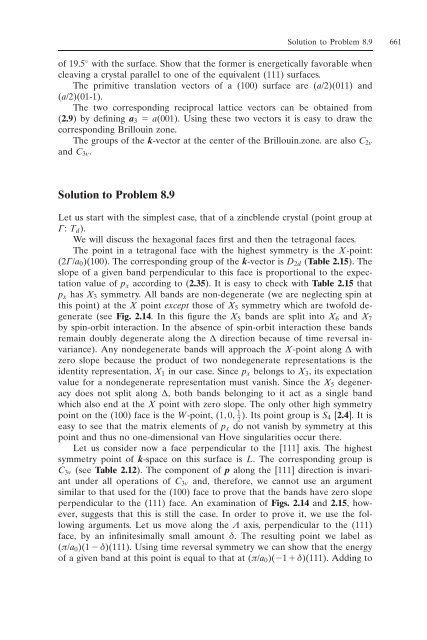10. Appendix
Create successful ePaper yourself
Turn your PDF publications into a flip-book with our unique Google optimized e-Paper software.
Solution to Problem 8.9 661<br />
of 19.5 ◦ with the surface. Show that the former is energetically favorable when<br />
cleaving a crystal parallel to one of the equivalent (111) surfaces.<br />
The primitive translation vectors of a (100) surface are (a/2)(011) and<br />
(a/2)(01-1).<br />
The two corresponding reciprocal lattice vectors can be obtained from<br />
(2.9) by defining a3 a(001). Using these two vectors it is easy to draw the<br />
corresponding Brillouin zone.<br />
The groups of the k-vector at the center of the Brillouin.zone. are also C2v<br />
and C3v.<br />
Solution to Problem 8.9<br />
Let us start with the simplest case, that of a zincblende crystal (point group at<br />
°: Td).<br />
We will discuss the hexagonal faces first and then the tetragonal faces.<br />
The point in a tetragonal face with the highest symmetry is the X-point:<br />
(2°/a0)(100). The corresponding group of the k-vector is D2d (Table 2.15). The<br />
slope of a given band perpendicular to this face is proportional to the expectation<br />
value of px according to (2.35). It is easy to check with Table 2.15 that<br />
px has X3 symmetry. All bands are non-degenerate (we are neglecting spin at<br />
this point) at the X point except those of X5 symmetry which are twofold degenerate<br />
(see Fig. 2.14. In this figure the X5 bands are split into X6 and X7<br />
by spin-orbit interaction. In the absence of spin-orbit interaction these bands<br />
remain doubly degenerate along the ¢ direction because of time reversal invariance).<br />
Any nondegenerate bands will approach the X-point along ¢ with<br />
zero slope because the product of two nondegenerate representations is the<br />
identity representation, X1 in our case. Since px belongs to X3, its expectation<br />
value for a nondegenerate representation must vanish. Since the X5 degeneracy<br />
does not split along ¢, both bands belonging to it act as a single band<br />
which also end at the X point with zero slope. The only other high symmetry<br />
point on the (100) face is the W-point, (1, 0, 1<br />
2 ). Its point group is S4 [2.4]. It is<br />
easy to see that the matrix elements of px do not vanish by symmetry at this<br />
point and thus no one-dimensional van Hove singularities occur there.<br />
Let us consider now a face perpendicular to the [111] axis. The highest<br />
symmetry point of k-space on this surface is L. The corresponding group is<br />
C3v (see Table 2.12). The component of p along the [111] direction is invariant<br />
under all operations of C3v and, therefore, we cannot use an argument<br />
similar to that used for the (100) face to prove that the bands have zero slope<br />
perpendicular to the (111) face. An examination of Figs. 2.14 and 2.15, however,<br />
suggests that this is still the case. In order to prove it, we use the following<br />
arguments. Let us move along the § axis, perpendicular to the (111)<br />
face, by an infinitesimally small amount ‰. The resulting point we label as<br />
(apple/a0)(1 ‰)(111). Using time reversal symmetry we can show that the energy<br />
of a given band at this point is equal to that at (apple/a0)(1 ‰)(111). Adding to










